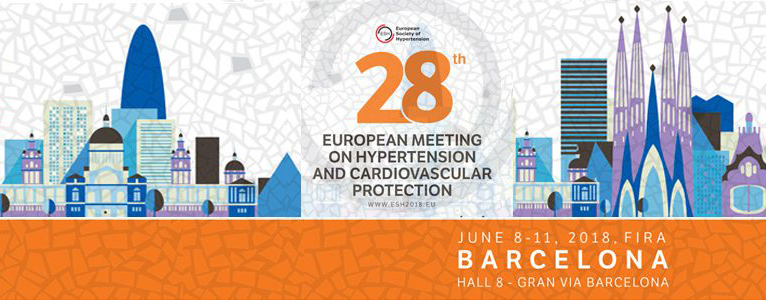
On 8-11 June, the 28th European Meeting on Hypertension and Cardiovascular Protection was held in Barcelona. The key message was the overview of the current guidelines of ESH/ESC on hypertension management 2018. Plenary sessions devoted to the discussion of the guidelines were overcrowded. These long-awaited guidelines (in particular, after the American guidelines were published in 2017), despite the expectations, did not cause either an explosion or an earthquake: the European experts appeared to be more conservative leaving the definition and classification of hypertension without any change. At the same time the two-stage target blood pressure levels sound uncommon, and future practice will show how convenient and achievable they are. The main changes include the issues related to the antihypertensive treatment, in particular, in resistant hypertension, intervention approaches, compliance assessment etc. Consequently, the leading experts and the authors of the guidelines announced the main issues. Professor K. Narkiewiecz (Poland) declared the expert’s position regarding definition and classification of hypertension. Professor J. Redon (Spain) talked about the office and out-of-office blood pressure measurement. Professor Agabiti Rosei (Italy) noted changes in risk stratification. Professor L.M. Ruilope (Spain) listed the indications for the antihypertensive therapy initiation. Professor G. Mancia (Italy) presented new target blood pressure levels, professor A. Coca (Spain) – approaches to the life style modifications, professor B. Williams (Great Britain) – algorithm for the antihypertensive therapy administration. The current president of the European Society of Hypertension (ESH) professor K. Tsioufis (Greece) presented the current position on the intervention approaches in hypertension, while professor R. Schmieder (Germany) gave the expert opinion on the hypertension treatment in special groups. Professor Burnier (Switzerland) talked aout the patients follow-up. Professor G. Mancia concluded with the long list of open questions and gaps requiring further investigation. The number of these gaps is 4:1 compared to the recommendations and constitutes 26 questions. They are: What is the optimal blood pressure measurement method in atrial fibrillation? What is the optimal population-screening programme for detecting hypertension? What is the incremental benefit for the CV-risk prediction of the addition of out-of-office BP to office BP measurement? What are the outcome benefits associate with antihypertensive treatment in patients with resistant hypertension? What are the benefits of BP treatment for patients with BP in the high-normal range, in elderly and young patients, etc.?
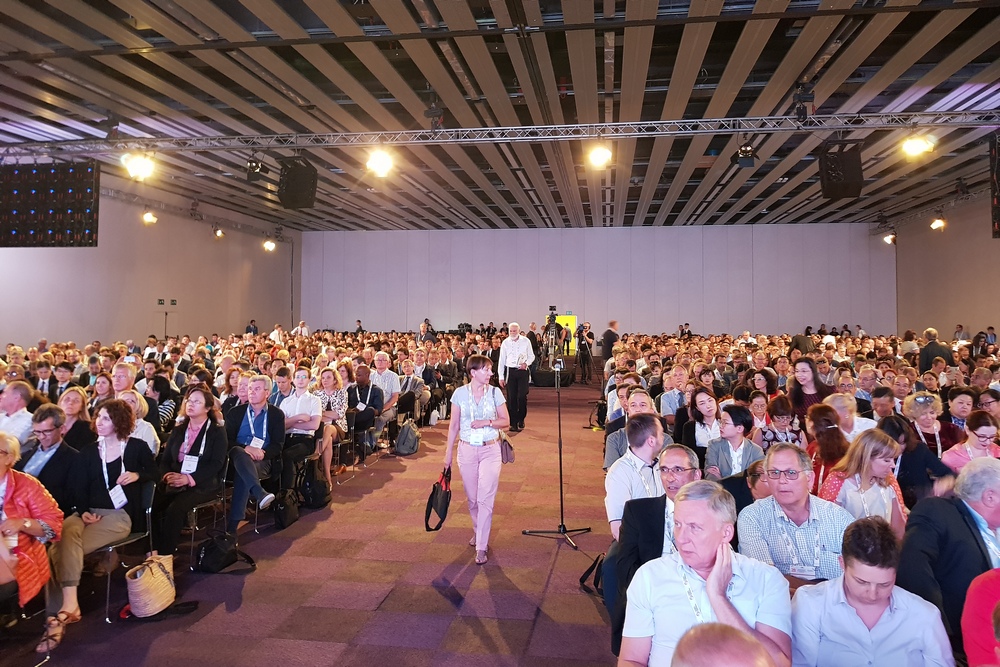
Those who could not attend the Congress, had the opportunity to follow the Plenary Session and the Guidelines presentation on-line (the recording is available here: http://www.eshonline.org/esh-annual-meeting/; in Russian a brief overview of the key messages is published in the journal “Arterial Hypertension”, issue #3 and is available on the Journal web-site htn.almazovcentre.ru).
According to the statistical report made by the ESH president professor K. Tsioufis (Greece) doctors from 67 countries took part in the Congress. Altogether 1145 abstracts were accepted: Italy took the 1st place (120 abstracts) followed by Russia (102 abstracts). Other countries followed far behind, including Spain, Greece, China etc. Besides common plenary sessions, satellite symposiums, breakfast sessions, the program included Topic Workshops, Joint sessions with other Societies, Teaching Seminars, Clinical Case sessions, Meet-the-Expert session, Hot Topic Sessions. In addition, the Balkan seminar, session of the Brazil Society of Cardiology, session of the Portuguese Society were held. Altogether, 178 oral presentation, 863 poster presentations and 71 oral presentations during the moderated poster sessions were performed. Russian specialists took an active part in the Congress giving 8 oral talks and 106 poster presentations (including joint studies with the international collaborators). However, none of the Russian specialists acted as a chairman during any of the sessions.
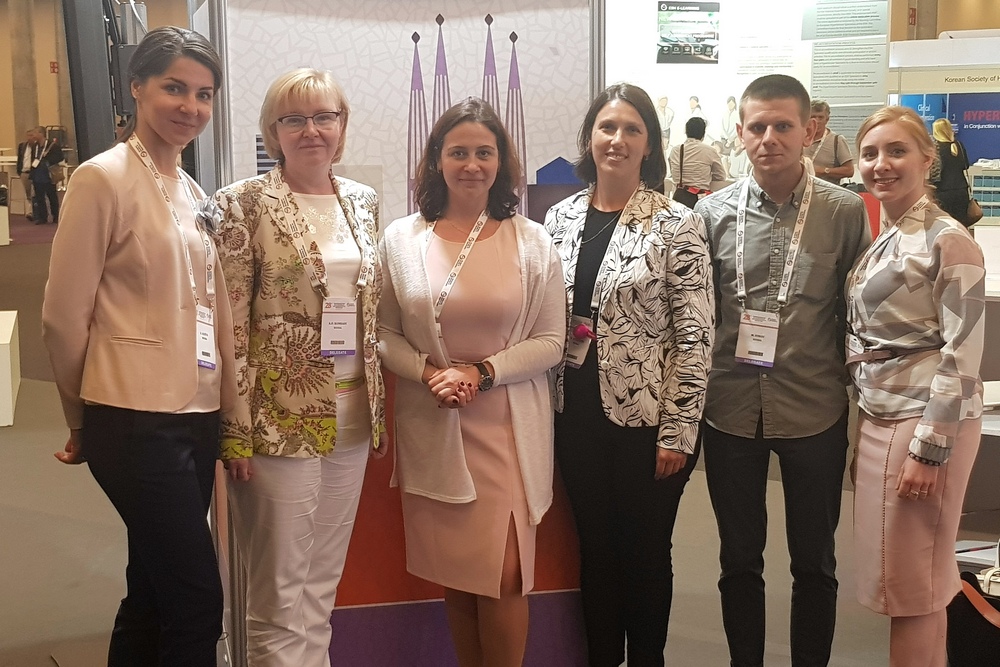
On the first day of the Meeting, the members of the ESH Task Forces briefly described the state-of-the art on the each filed in hypertensiology, i.e. device-based therapy in hypertension, management in acute stroke depending on the stroke subtype, treatment of the high-risk patients, patients with endocrine hypertensions, sexual dysfunction, cardiovascular prevention in the low resource settings etc.
Further, the most common topics were the antihypertensive drug and device-based treatment, personalized medicine, therapy in special groups (pediatrics, elderly patients etc.) and conditions, combination therapy. At the session of experimental studies and pharmacology Dr. N. Zvartau (St Petersburg) convinced the audience that the big data and their analysis is the basis for the precise and personalized medicine, as by models which include various individual parameters enable prediction of the response to the therapy, make prognosis etc.
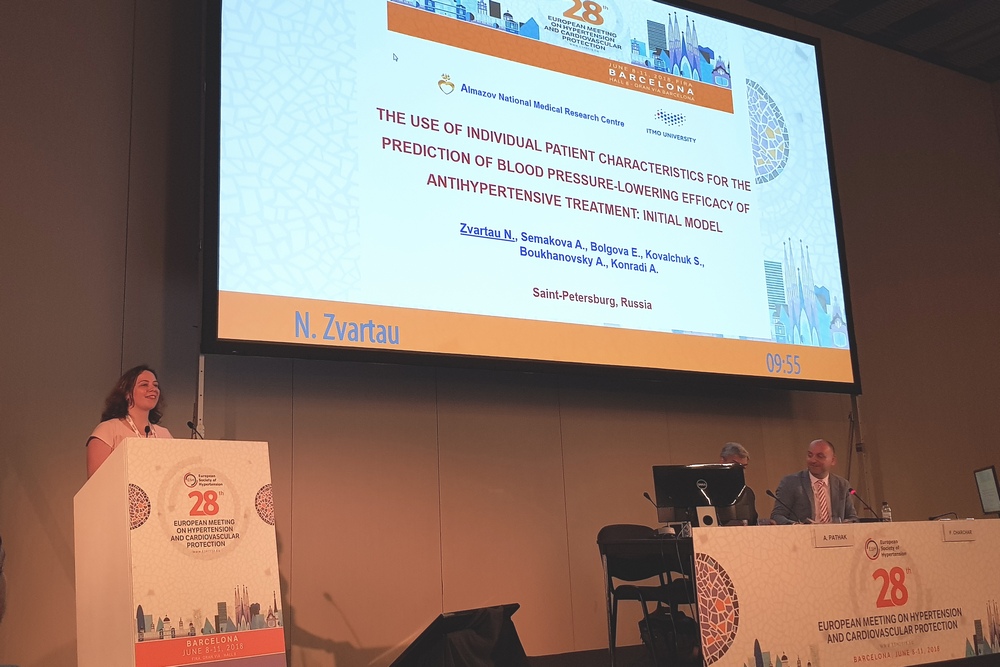
N. Zvartau (St Petersburg)
Despite great number of drugs and device-based approaches, resistant hypertension remains the stumbling block in cardiology. Several sessions discussed issues related to the refractory hypertension. In particular, the diagnostics of fibromuscular dysplasia and its variants drew a lot of attention. Professor A. Pesu (Belgium) presented the first results of the European Registry of fibromuscular dysplasia. Device-based methods were actively discussed, i.e. baroreflex activation, sympathetic renal denervation, carotid stimulation, aortic arch stimulation, arteriovenous fistula etc. At one session, the long-term outcomes of the neurovascular decompression of the brainstem were reported in a small sample. The authors believe that in some cases this method can be highly effective when the blood pressure variability is due to the anatomical features of the cerebral circulation. In a session on resistant hypertension two reports by Russian scientists were included: Dr. T. Ripp (Tomsk) presented the results of the efficacy of distant versus conventional renal denervation, and Dr. L. Korostovtseva (St Petersburg) reported the changes in asymmetric dymethylarginine after renal denervation.
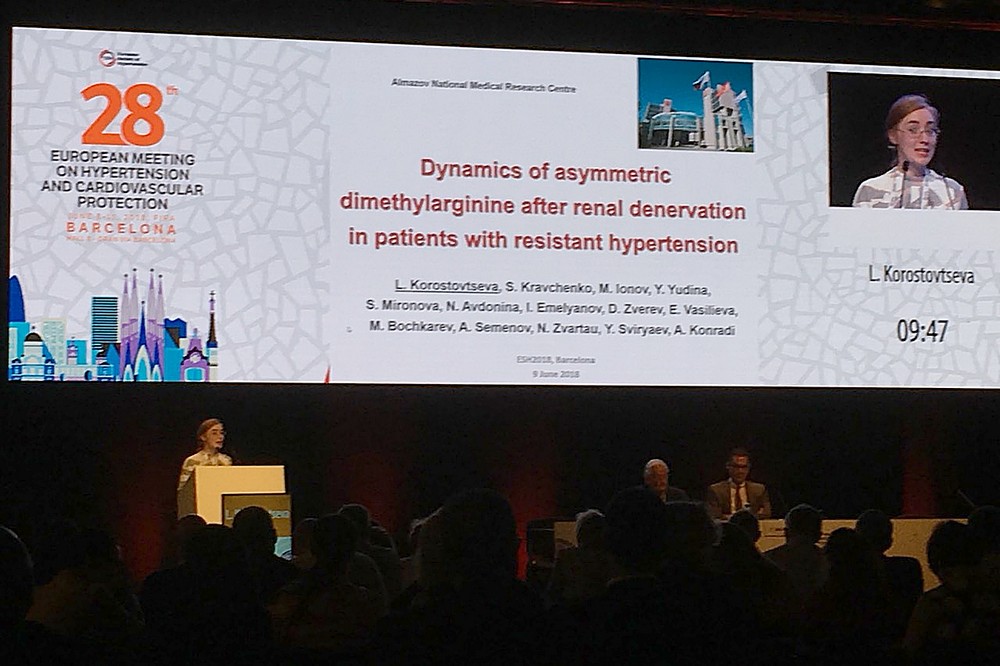
L. Korostovtseva (St Petersburg)
Dr. M. Tomaszewski (United Kingdom) gave a lecture on the pseudo-resistance, presenting several striking examples of low compliant patients. In these cases a doctor should act as a detective catching the patient as a non-adherent liar. Despite high costs, laboratory methods of drug detection in urine and blood are widely implemented in the research and routine clinical practice. Novel technology, so called “Digital spy”, is a device which can read information on the time of drug intake from a chip built in a pill. The developers believe that this technology can increase the compliance, however, the idea of the patient shadowing seems non-compliant with the deontology.
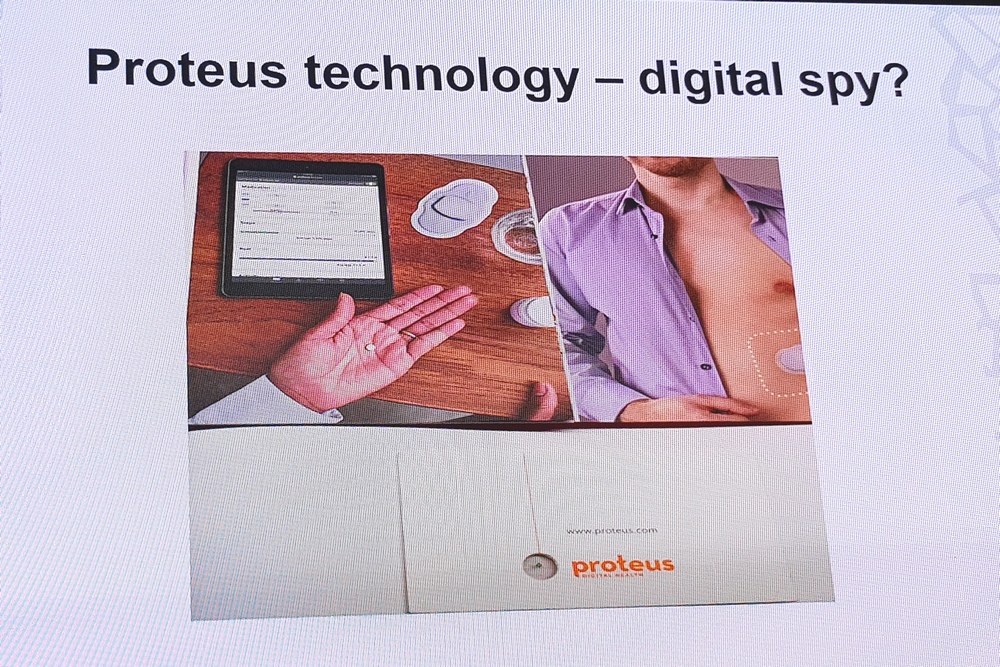
A rapidly developing field in healthcare i.e. use of information and communication technologies is a promising field. These technologies can help to establish doctor-patient «partnership», reduce therapeutic inertia, provide multiple opportunities to communicate with the patient and may potentially reduce treatment costs. During a separate session mHealth (mobile Health) related issues were discussed, in particular, its potential for the low resource settings.
Several reports were devoted to different methods of blood pressure measurement (office and out-of-office, cuff-based and non-cuff-based etc.), their role for population screening programs, diagnosing masked hypertension, prognostic role of different thresholds. Professor G. Parati (Italy), the pupil of Professor A. Zanchetti, remains the leading expert in the field of blood pressure monitoring. In his talk, he emphasized the difficulties of blood pressure monitoring in hypertensive obese patients.
A lot of attention was drawn to other issues of risk factor modification, screening programs for early vascular aging (EVA) detection. Professor S. Laurent (France) and professor P. Nilsson (Sweden) are the leaders and movers of the field. Metabolic disorders, including diabetes mellitus, dyslipidemias, hyperuricemia were also hot topics for discussion. During the session on diabetes, Russian specialists presented their data: Dr. I. Pchelin (St Petersburg) talked about the relation between proinflammatory markers and cardiovascular and renal function in diabetes. Professor L. Minushkina (Moscow) presented original data on the impact of SGLT2 inhibitors on the blood pressure variability.
A “novel” risk factors included in the new guidelines is the anxiety and psychological stress. The stress-related issues were discussed during the breakfast session.
At the meet-the-expert sessions, the participants learnt how to use the genetic studies in cardiovascular pathology (chairperson – professor А. Dominiczak, United Kingdom), what is the role of microRNAs in hypertension and target-organ damage (chairman – professor T. Unger, the Netherlands), and had the opportunity to discuss the weak points of the SPRINT study (chairman – professor L. Lindholm, Sweden).
At traditional debate session, the definition and classification of hypertension were discussed. However, after the presentation of the novel European guidelines the hot dispute did not take place, despite the efforts of the chairman to increase the temperature and provoke the speakers. American position was presented by professor P. Whelton (USA) was not supported by the audience (2 votes against the rest of the public). However, he accepted that the American guidelines 2017 caused a real epidemiological revolution and called for collaboration to unite the efforts.
Frequent complications of hypertension, including heart rhythm disorders and heart failure as the final stage of cardiovascular continuum, were also discussed. The well-structured report by professor E. Baranova (St Petersburg) on the original paper of the association between fibrosis markers of the epicardial fat and paramteres of electroanatomical mapping in atrial fibrillation caused a vivid discussion. Dr. M. Markov (Moscow) presented a concept of the pathogenic link between unilateral carotid occlusion and pulmonary hypertension.
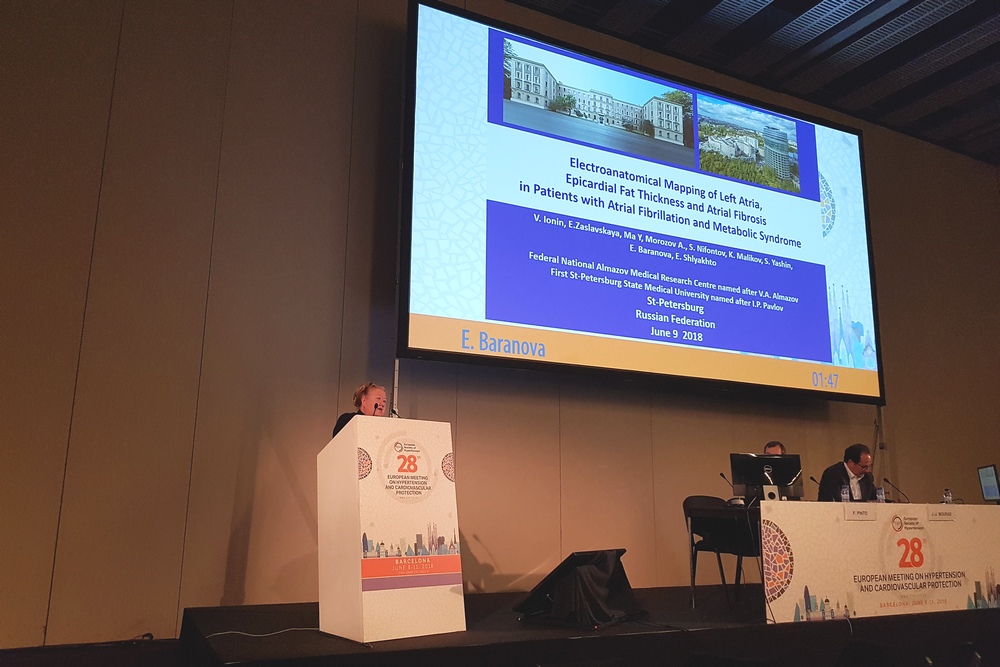
E. Baranova (St Petersburg)
Before the Congress, the third meeting of the International Hypertension Club was held in Barcelona. The Russian delegate Dr. N. Zvartau (Almazov National Medical Research Centre, St Petersburg) briefly reported the need for developing guidelines on hypertension treatment in patients with liver disease which excited high interest and dispute. After the guidelines 2018 were presented, it appeared that hepatocardiovascular association remains one of the gaps in the knowledge. However, a tight collaboration with gastroenterologists will help to fill in this gap by the future update of the guidelines.
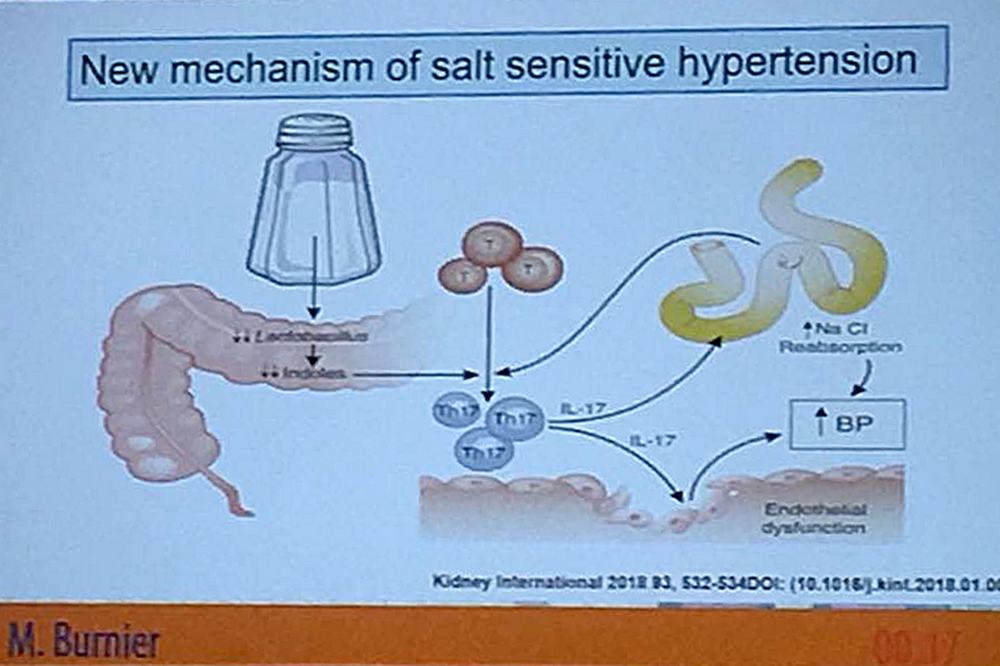
It should be noted that the relation between hypertension and gastrointestinal disease have been repeatedly discussed during the congress. In particular, the role of gut microbiome in the development of cardiovascular disease seems to be important. Professor D. Mueller (Germany), the awardee of the Bjorn Folkow award, offered solid arguments how the excessive (and even moderate) salt consumption inhibits the growth of the normal gut microorganisms (Lactobacillus), consequently, leading to the activation of the non-specific cell immunity which can increase the inflammation and atherosclerosis development and progression. Regarding this, he well-known recommendation of salt restriction gets a new pathogenesis basis.
In general, the Meeting 2018 was dedication to professor Alberto Zanchetti (27 July 1926 – 24 March 2018), who has passed away at age of almost 92 years. This outstanding researcher continued investigations and teaching activities till the last day. During his life he made research in various fields, but the most the cardiovascular regulation, both central and autonomic. He was one of the pioneers to implement ambulatory blood pressure monitoring into practice. He was the founder of the International and European Societies of Hypertension… One can hardly list all the achievements of professor A. Zanchetti. For many years, he was the main mover, inspirer and organizer of the annual meetings which gathered specialists from all over the world, giving the opportunity for international experience exchange from different fields and establishing new collaborations in hypertensiology. For many specialists he became the Mentor, Guru, Advisor and an example of high professionalism, devotion to profession, research, high moral principles and humane and kind attitude to everyone he met. Many of his pupils attended the Congress to honour is memory and to observe a minute of silence.
Another dedication was held within the Congress. The whole plenary session was the celebration of th 90-year anniversary of the famous, extraordinary researcher Professor Stevo Julius.
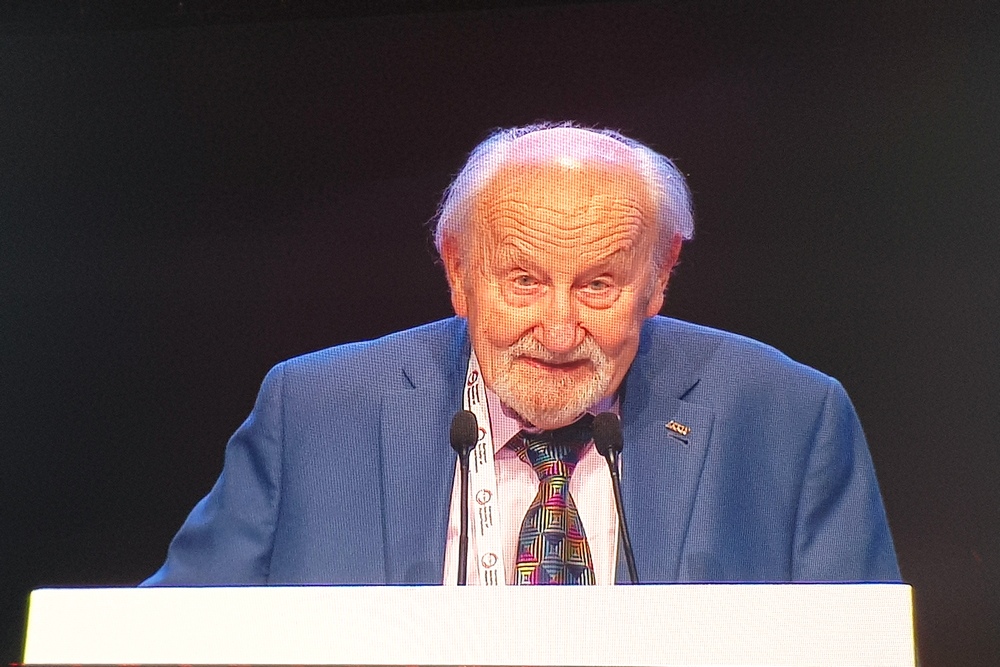
Professor Stevo Julius
The session was touching, emotional, informal. His pupils, colleagues, friends came from different parts of the world (Australia, USA, Philippines etc.) to express their love, friendship, gratefulness and to share their memories on collaborative projects and studies with Professor Julius. Professor M. Esler (Australia) briefly reported the main achievements and discoveries by professor Julius regarding the role of nervous system in hypertension and cardiovascular disease. Professor B. Egan (USA) continued with the overview of the hemodynamic studies. Dr. S. Nesbitt (Dallas, Texas, USA) reported the main results of the legendary study TROPHY, which demonstrated the impact of high-normal blood pressure in cardiovascular risk. Finally, these results contributed to the recent changes in hypertension classification offered by American experts in 2017. Professor A. Mejia (Philippines) ggave an overview of the Tecumseh study, which she called the Julius’ Framingham study. Professor К. Jamerson (USA) is the only one of the presenting speakers who till nowadays works together (nip and tuck) with professor Julius in the Michigan University Clinic. He talked of the autonomic regulation in metabolic syndrome investigated by professor Julius. Professor P. Palatini (Italy) summarized the results on the investigation of the association between heart rate and cardiovascular disease. These studies strated as early as in 1990-s, including the study VALUE, and they had a big impact inspiring European experts for a Consensus paper (2016) on management of patients with hypertension and high heart, as well as resulted in the inclusion of high heart rate in the list of cardiovascular risk factors (2018). The pupil and friend of professor Julious Professor (S.E. Kjeldsen, Norway) concluded by the summary of the main results of the studies HOT, LIFE and VALUE which were planned and designed in a logic sequence and became the classical studies in cardiology. Each speaker brought a piece of informal presentation – personal memories, archive photos from 1950—1970s), study-related anecdotes etc. Thus, Professor M. Esler demonstrated a photo rom a boat trip taken during the early career of professor Julius. Professor S.E. Kjeldsen presented “The Masterminds of the Clinical Trials in Hypertension” – Stevo Julius and Lennart Hansson who inspired and designed the studies HOT, LIFE and VALUE, which drastically changed our understanding of hypertension-related risks and treatment. In the end of the session, professor Julius extended appreciation to all the speakers as well as the audience. He expressed special gratitude to his wife, his partner and keeper of all the scientific parties. In conclusion, he wished all the audience and all the scientists not to take science as a dull business. Memorizing his life and experience, he told that for him and his colleagues the time of study planning and conducting was the best and full of joy (hiking, kayak-paddling, small parties and big festivals during the joint meetings and discussions). He wished to everyone to turn the routine into a festival and to get joy and pleasure in everyday work.
In general, this complies with the concept presented by the Dr. Vlachopoulos (Greece) and supported by other experts in the field of vascular aging. According to the recent publications, the best way to improve the vascular age, to decrease the arterial stiffness include 3 factors: walking in the natural environment, listening to the favorite music (either classical or rock, or any other but favorite one), and relaxation.
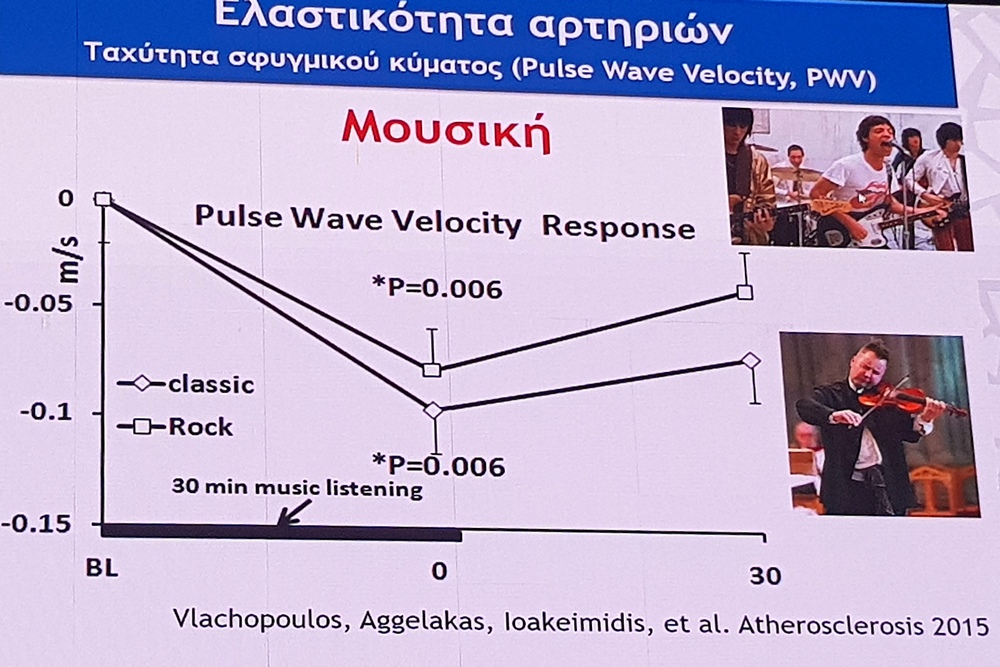
The concept presented by the Dr. Vlachopoulos (Greece)
Intriguingly, Barcelona gives all the opportunities for the cardiovascular protection, and the attendance of the 28th ESH Meeting became one of the festivals which professor Julius promoted. It became the place of meeting old friends and planning new collaborations. Strolling around Montjuic, spending evenings nearby the singing fountains at the Spain square, walking in the legendary Park Guell, where every adult person can become a child again and visit the houses from a fairytale meeting Salamandra which became a symbol of Barcelona, wonderful views on the Mediterranean sea, sitting on the longest and the most comfortable in the world bench created by the genius of Antonio Gaudi… On top of that, Mediterranean diet, Spanish wine and maritime air – taken together it makes a great 3-day-long intensive course on cardiovascular prevention!

The Guell Park
Also on behalf of young scientists who took part in the Congress, we express our gratitude to the leadership of the Almazov National Medical Research Centre and the Young Scientists and Specialists Board for the opportunity to attend the 28th European Meeting on Hypertension and Cardiovascular Protection.
The material was prepared by the staff of the Research Department of Hypertension and the Research Department of the Epidemiology of Cardiovascular (Non-infectious) Diseases: L.S. Korostovtseva, M.V. Ionov, N.E. Zvartau, N.G. Avdonina, A.S. Alieva, A.O. Konradi.
